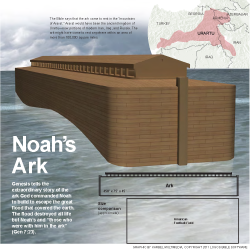1:1–9:44 The books of 1 and 2 Chronicles |
1:1 Adam The Chronicler uses the format of a genealogy starting with Adam to review the story of the ot from Genesis to the postexilic period of Ezra and Nehemiah. The people listed in vv. 1–4 are mentioned in more detail in the genealogy of Gen 5.
1:4 Noah The man God saved from the flood,
God saved from the flood, along with his sons and their families. See Gen 6–9.
along with his sons and their families. See Gen 6–9.
1:5–23 This list is based closely on the Table of Nations in Gen 10. The Table of Nations divides up the known world according to its descent from the sons of Noah. See note on Gen 10:1–32. |
 Understanding the Table of Nations
Understanding the Table of Nations
1:7 Rhodanim The same as “Dodanim” in Gen 10:4. The Hebrew letters for “d” and “r” are very similar (see note on Gen 10:4).
letters for “d” and “r” are very similar (see note on Gen 10:4).
1:19 in his days the earth was divided The name “Peleg” comes from the Hebrew word palag, meaning “to divide.”
1:24–27 This list of the descendants of Shem includes the names, but not the details, from the genealogy in Gen 11:10–26 (see note on Gen 11:10–26). |
1:27 Abram, that is, Abraham “Abram” means “exalted father” while “Abraham” means “father of many.” God changed his name from “Abram” to “Abraham” after making a covenant with him (see Gen 17:5 and note).
means “father of many.” God changed his name from “Abram” to “Abraham” after making a covenant with him (see Gen 17:5 and note).
1:28–42 While the Genesis narrative emphasizes the sons who inherited God’s promise to Abraham, Isaac |
1:29 Ishmael Abraham’s son by Hagar, Sarah’s servant. Since Sarah had not borne any children, she offered her servant to Abraham as an alternate means for him to gain a son and heir (Gen 16:1–4). After Isaac was born, Sarah insisted that Hagar and Ishmael be sent away (Gen 21:10).
1:32 Keturah Abraham’s third wife or concubine (Gen 25:1). She is not mentioned until after Sarah has died (Gen 23:1–2; 24:67), giving the impression that Abraham took her as a wife after Sarah’s death. Her six sons represent Arab tribes associated with the incense trade in the Arabian desert (Gen 25:1–6).
1:33 Midian Ancestor of the Midianites and the name of a region in the northwest Arabian peninsula, east of the Gulf of Aqaba and north of the Red Sea. Moses fled to Midian
and the name of a region in the northwest Arabian peninsula, east of the Gulf of Aqaba and north of the Red Sea. Moses fled to Midian when Pharaoh was trying to kill him (see Exod 2:15 and note).
when Pharaoh was trying to kill him (see Exod 2:15 and note).
1:34 Isaac The son God promised to Abraham and Sarah (Gen 17:16; 18:9–15). Isaac also was Abraham’s primary heir (Gen 24:36; compare Gen 25:6). This verse refers to Jacob as “Israel”—the name he was given by God (Gen 32:27–28).
also was Abraham’s primary heir (Gen 24:36; compare Gen 25:6). This verse refers to Jacob as “Israel”—the name he was given by God (Gen 32:27–28).
1:35 Esau Isaac’s oldest son (Gen 25:25); also called “Edom” (Gen 36:8). He is the ancestor of the Edomites. Esau’s younger brother Jacob acquires his blessing and birthright.
Esau’s younger brother Jacob acquires his blessing and birthright.
1:38 Seir The region where Esau settled (Gen 32:3) and where the Edomites lived (Deut 2:4). The Horites
(Gen 32:3) and where the Edomites lived (Deut 2:4). The Horites lived in the area before the Edomites (Gen 14:6; Deut 2:12, 22).
lived in the area before the Edomites (Gen 14:6; Deut 2:12, 22).
1:43–54 This passage about the ancient kings of Edom is virtually identical to Gen 36:31–43. The list of kings also follows the similar genealogy of Esau in Gen 36:9–30. See note on Gen 36:31–39. |

|
About Faithlife Study BibleFaithlife Study Bible (FSB) is your guide to the ancient world of the Old and New Testaments, with study notes and articles that draw from a wide range of academic research. FSB helps you learn how to think about interpretation methods and issues so that you can gain a deeper understanding of the text. |
| Copyright |
Copyright 2012 Logos Bible Software. |
| Support Info | fsb |
 Loading…
Loading…



